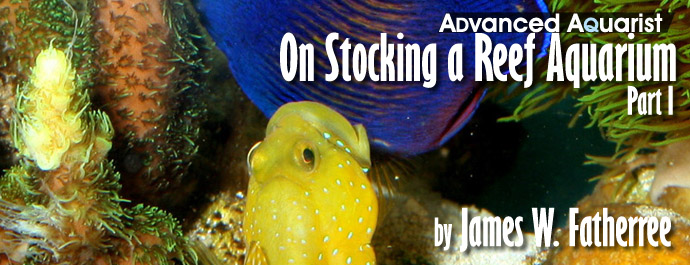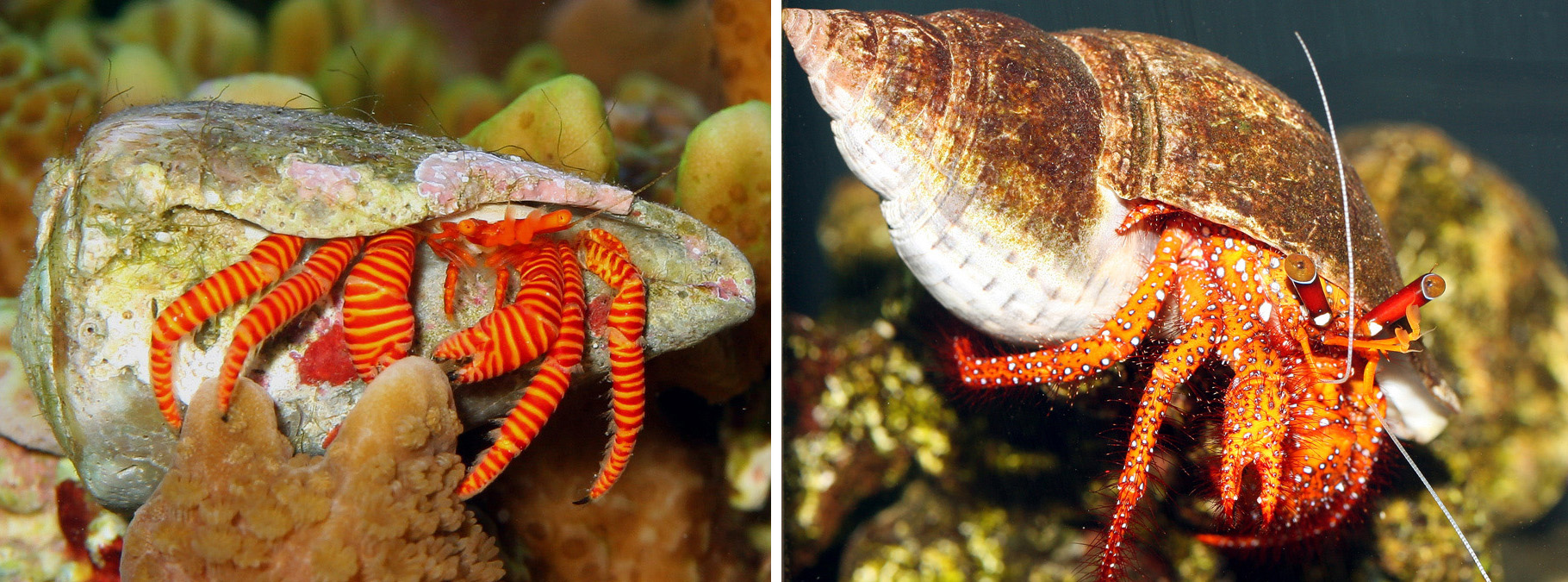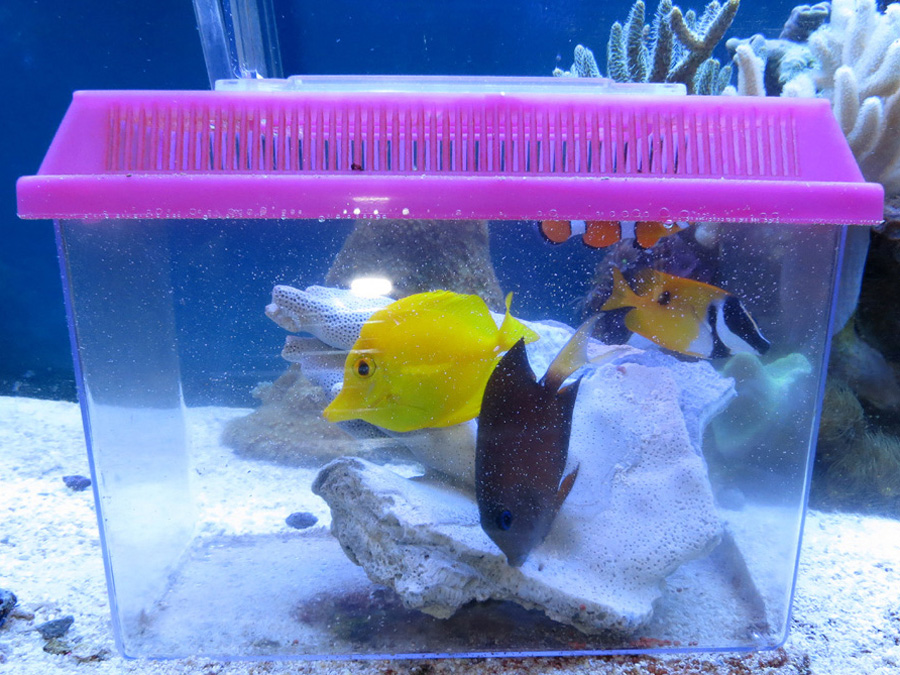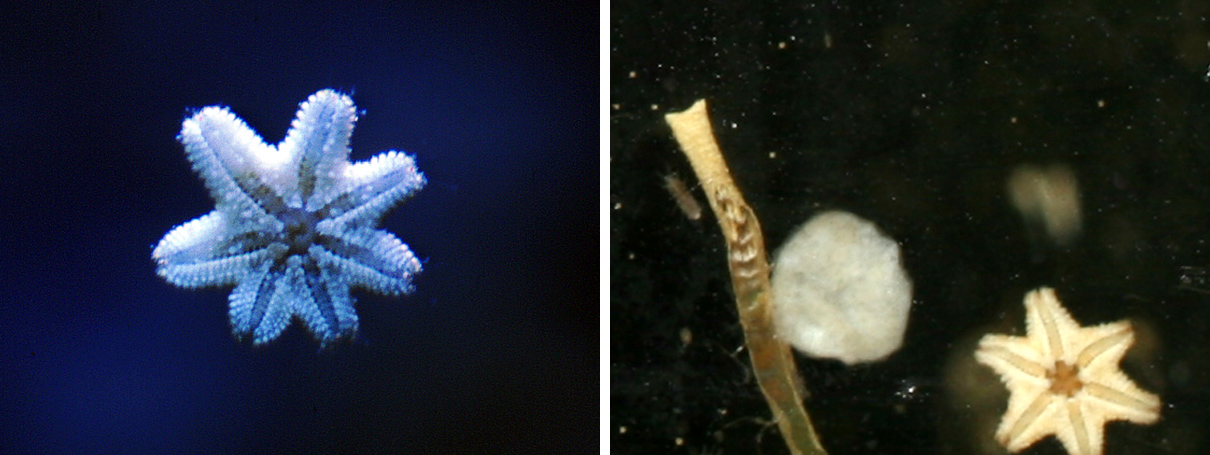
In a previous article, I presented information on the livestock in my 125 gallon mixed-reef aquarium, as well as the equipment and maintenance required to take care of everything (Fatherree, 2014). I also pointed out that there had been compatibility issues with some livestock in the past and the present. A lot of things have been placed in and taken out of the aquarium, seeing what works and what doesn’t, and what I have now is the result of quite a bit of trial and error. Many things have presented issues as they’ve grown closer and into contact with each other, as well.
So, I’ll cover the subject of compatibilities in two articles with the hopes of making the planning and stocking process easier for other reef aquarium hobbyists. I’ll also give some tips on how to deal with a few problems, such as trapping problematic fishes. For now we’ll look at the fishes and non-cnidarian invertebrates, with cnidarians and humans coming next.
The Fishes
Before I say anything about my own experiences with fishes, it’s important to remember that every fish is an individual and every one of them has its own personality. It’s easy to make general statements based on my own experiences as a hobbyist and former aquarium maintenance business owner, and those of many other hobbyists, but it seems that there are always exceptions. An individual of a species that’s well known for being peaceful may be the one in a hundred that’s quite aggressive. Or, you may find an occasional fish that’s thought to be aggressive, but turns out to be the nicest fish in a tank. So, when it comes to behavior, generalizations are exactly that – generalizations. I cannot guarantee that any kind of fish added to another aquarium will act as they have in mine/my customers’. With that said, here’s what I have at this time:
- One yellow coris wrasse, Halichoeres chrysus
- One Randall’s shrimp goby, Amblyeleotris randalli
- One foxface rabbitfish, Siganus vulpinus
- One scopas tang, Zebrasoma scopas
- One yellow tang, Zebrasoma flavescens
- One two spot tang, Ctenochaetus binotatus
- One unidentified tang, Ctenochaetus sp.
- One tomini tang, Ctenochaetus tominiensis
The Randall’s shrimp goby was a relatively late edition. I formerly had a yellow rose/highfin goby (Stonogobiops nematodes) living with my Randall’s pistol shrimp (Alpheus randalli), but after doing well for at least a couple of years the goby disappeared, never to be seen again or found on the floor. I also tried a mated pair of pink bar/aurora gobies (Amblyeleotris aurora), but both ended up jumping out of the aquarium and were found on the floor within a few weeks of being added. I obviously do not have glass lids on the aquarium, but the lighting fixture is 14 inches wide, leaving a gap of only one inch at the front and rear between the fixture and the aquarium’s upper frame. Nevertheless, both of these fishes managed to jump through the small gap at the front of the aquarium. I never saw them being harassed by the other fishes, and for that matter, I never witnessed them attempting to jump from the aquarium, either. So, I don’t have any idea why they did so.

The yellow rose goby, aurora goby, and Randall’s shrimp goby, all lived with the Randall’s pistol shrimp.
Regardless, all of these gobies paired with the Randall’s pistol shrimp and never caused any problems with other fishes or invertebrates of any sort, nor were they harassed by other larger fishes. They’re typically rather skittish fishes though, often darting into their shrimp-built burrows whenever any other fishes get within a few inches of them.
I’ll add that I’ve had several different species of small shrimp gobies that haven’t been a problem, but also had a yellow watchman goby (Cryptocentrus cinctus) in the aquarium before the yellow rose goby, which was quite different. Not only does this species get much larger than the other shrimp gobies, it typically does not shy away from other fishes that come close to its burrow. In fact, once it grew to maturity, mine would very aggressively defend the area near the burrow, even against fishes that were significantly larger. It never injured the other fishes, but you’d think it was trying to eat them at times. It also lived with a different species of shrimp, being a tiger pistol shrimp ( Alpheus bellulus), which passed away after a few years. So, I swapped out the big goby for the much smaller yellow rose goby and the smaller Randall’s pistol shrimp.
The foxface rabbitfish is another long-time favorite that I’ve had at home and in customers’ aquariums. This one also gets along well with almost everything else, and has presented no problems. I must say “almost everything else” though, as it occasionally gets into short squabbles with my scopas tang for no apparent reason. When this happens, it’s always the tang that seems to be the aggressor, and they both dance around each other and slap bodies for a few seconds. Neither has been injured during these spats though, and they pay little attention to each other most of the time.
Note that some rabbitfishes have reportedly fed upon both soft and stony corals in reef aquariums, most often zoanthids and button polyps. However, I have personally cared for several foxfaces over the years and have not had a problem with them. I suspect that keeping them well fed prevents such issues.
The yellow coris wrasse was in another heavily-stocked reef aquarium of mine, which I shut down a few years ago. I liked it though, so I moved it into the 125g. It has never caused any problems with other fishes or invertebrates of any sort, nor has it been harassed by other larger fishes. Note that this species does sleep in the sand bed though, so it’s best kept in an aquarium with a substrate of at least two inches of fine sand.
Many tangs live in schools in the wild, but trying to keep two or three of the same species of any of these in one tank will usually lead to fighting. It’s an odd thing, but in the confines of an aquarium, they typically just won’t get along with each other. It’s more often possible to keep two or more from different genera together, such as a yellow tang (Zebrasoma) and a two spot tang (Ctenochaetus), but sometimes this won’t work out, either. However, I obviously like tangs, and have successfully kept five different ones together for quite some time now.
What has worked well for me over the years is to simultaneously add two or three individuals of differing species to a larger aquarium (as in over 100 gallons), with all the tangs being roughly the same size. For whatever reason, this has been successful many times, while trying to add the same fishes at different times has not. So, I added the yellow tang, scopas tang, and two spot tang at the same time, with all being about two and half inches in length. This worked very well, and all three spend a lot of time swimming around together as if they were friends. They don’t bother anything else, and nothing bothers them.
I wanted a couple more, though. So, several months later I simultaneously added the unidentified tang (I’d never seen one and it was cheap) and the tomini tang. I intentionally got these at a smaller size than the other three tangs, with both being about two inches in length. I was aware that this still might not work, but was ready to trap and remove either or both if necessary.
Both were repeatedly harassed by the other tangs for a few days, but were never injured with the exception of some minor cuts on their fins. So, I waited to see if everyone would calm down, and they did. However, after several weeks the unidentified tang started acting aggressively towards the tomini tang. It began to chase off the tomini at feeding time, with the tomini retreating to the far end of the tank from where I added food. I considered removing the unidentified tang at first, but the tomini still got plenty to eat and stayed healthy anyway, was not bothered at other times, and was never seriously injured. So, I left everyone alone.
This squabbling between the two has continued for a couple of years and has gotten no better, but has gotten no worse, either. Overall, all five tangs get along well, and again, they don’t bother anything else, and nothing bothers them. I do have to say, this is very unlikely to work for some other species, though. Some species, like the sohal tang, clown tang, and even purple tang (Acanthurus sohal, A. lineatus, and Zebrasoma xanthurum) can be surprisingly aggressive towards not just other tangs but other types of fishes, at times. So, I wouldn’t try mixing these with other tangs.

The yellow coris wrasse, all five tangs, and the foxface rabbitfish get along very well, almost all the time.
With the current fishes covered, note that I’ve had some other issues in addition to the loss of three gobies. For starters, I had a cherub angel (Centropyge argi) for a few years, which also got along well with the others and never caused any problems. It also disappeared one day never to be seen again despite being very healthy. Losing this fish after the disappearance of the yellow rose goby and the bailing out by the pink bar gobies made me start to wonder if I had a large predatory worm of some sort in the aquarium. However, after setting up a simple soda-bottle trap in different positions for a few nights, I never found any evidence of such. So, I still have no idea what happened to these fishes.
Anyway, I also had a coral beauty angelfish for a while, but it had to go when it started nibbling on my derasa clam. The clam and the fish had been in the aquarium together for at least two years without issue, but for some reason the angel started biting the clam, which left visible dimples in its mantle. Still, prior to that, the angel had gotten along perfectly well with the other fishes, and never bothered any other invertebrates. Do note that the coral beauty and cherub angels were not in the aquarium at the same time, as the cherub was more of a replacement for the coral beauty. It is highly unlikely that these two species would have gotten along, as cherubs can be surprisingly aggressive towards other similar fishes.
I’ve also had a pair of tank-raised ocellaris clownfish (Amphiprion ocellaris) in an aquarium at school, and in the summer I typically remove and bring them home where I can feed them daily without relying on an automatic feeder. When the holidays are over it’s time for the clownfish to go back to school. So, I trap them and move them back to their original aquarium. These fishes are also peaceful, never bothering anything else, or being picked on. Well, except that one decided to take up residence on top of my derasa clam, which the clam didn’t care for at first. Initially, the clam would jerk and quiver when the clownfish got too close or touched its mantle, but it became acclimated to the fish’s activities over a few days and stopped reacting to its presence after that.
Lastly, I had a King damsel (Chrysiptera rex) damsel too, which I also trapped and removed. It didn’t cause any problems, but it tripled in size, wasn’t especially attractive, and just didn’t need to be there. It wasn’t aggressive, and never got picked on, but I simply didn’t enjoy having it in the aquarium any more. So, I trapped it. Of course, many damsels can be terrors in an aquarium, but this one was fine. It’s the only one I’ve ever had of this species, so I can’t really say anything about the behavior of other individuals kept with other sorts of fishes.

The coral beauty had to go, the cherub angel disappeared after several years, the ocellaris clowns are transients, and the King damsel was moved to another aquarium.
Before moving on, in case you’re wondering, the soda-bottle trap I’ve used to remove worms is just a standard 20 ounce plastic bottle with a narrow top. You can put a few pebbles in one to keep it in place, add some fish meat or pellet food for bait, and force it partially into the sand bed until the bottom edge of the top/opening is even with the surface of the substrate. I’ve used it at night when all the lights were off, and in one case had to move it from place to place with the opening facing the base of the live rock structure in the aquarium. If a carnivorous bristle worm smells the food, they’ll snake into the bottle for a meal, and I’ve just reached in a grabbed the bottle before the worm could retreat. Some patience and a dim flashlight are required, but it works well enough.
My fish trap is a little more complicated, but still rather simple. In the photo below, you can see that I’ve placed a small plastic box in the aquarium, with a piece of coral skeleton in it to keep it in place on the bottom. I found it at a local pet store and it’s for keeping small reptiles or maybe a spider, etc. and has a flap-type door on the top that snaps shut.
When I need to trap a fish I place the box in the aquarium, and for a couple of days I only feed the fishes with sinking pellets. Then, I start using a three-foot piece of rigid airline tubing to drop the pellets into the clear box, and only in the box. So, if the fishes want to eat, they have to swim into the box. I also stand the tubing on the top the box, next to the door, to keep water flow from pushing the door over, and to close it when the time comes. Of course, the other end of the tubing sticks out of the top of the aquarium.
The tangs have always been the first to go for the food in the box when I’ve used it, and eventually the clam-biting coral beauty angel swam in for a meal, too. When it went in, I slowly grabbed the top of the tubing and quickly shut the door on the box with the angel and a couple of tangs inside. So, I had it trapped, pulled the box out, released the tangs, and took the angel to a shop for trade. This worked just as well for the damsel, the clowns, and several other fishes in the past, too.
Note that some fishes will swim into the box almost immediately upon seeing the pellets go in, but some have been more skittish and took a couple of days to get used to its presence, and then darted in and out several times before calming down and spending any time in it. Regardless, even the most skittish fishes will go in at some point, typically after seeing other fishes going in and out without issue for a while. Again, this can take a few days, though.
The Non-cnidarian Invertebrates
With respect to the non-cnidarian invertebrates, for the most part I’ve had no issues with what I have in the aquarium, although I have removed a couple of things. Here’s the list of current inhabitants:
- One Randall’s pistol shrimp, Alpheus randalli
- One skunk cleaner shrimp, Lysmata amboinensis
- One peppermint shrimp, Lysmata sp.
- One bumble bee shrimp, Gnathophyllum americanum
- Approximately twenty blue leg hermit crabs, Clibanarius tricolor
- One scarlet hermit crab, Paguristes cadenati
- One Halloween hermit crab, Ciliopagurus strigatus
- One zebra hermit crab, Calcinus laevimanus
- Two porcelain crabs, Petrolisthes sp.
- One sand stirrer star, Archaster typicus
- Dozens of asterina stars, Asterina sp.
- Hundreds of small unidentified brittle stars
- Six astrea snails, Astraea tecta
- Three zebra turbo snails, Turbo sp.
- Approximately twenty unidentified vermetid snails
- One derasa clam, Tridacna derasa
- Approximately six species of unidentified sponges
- Dozens of small unidentified feather duster worms
- Dozens of tentacled tube worms, Phyllochaetopterus sp.
- Hundreds of small unidentified bristle worms
- Hundreds (thousands?) of unidentified zooplankters
Of everything on the list, no problems should be expected, with the possible exception of one of the hermit crabs, the asterina stars, and the bristle worms. So, I’ll say something about them.
When it comes to the small blue leg, scarlet, and zebra hermits, there are no problems. These hermits are active all day, and pick algae off the live rock, and help clean up left over food. I’ve never had any of these eat anything that I wouldn’t want eaten. However, they do crawl all over both the stony and soft corals at times, which can temporarily annoy the corals and make them pull in their polyps. The hermits don’t do any damage though, and the corals’ polyps typically re-emerge within minutes of a hermit moving on.
The same can be said for the larger Halloween hermit crab. It incessantly picks at algae and hasn’t nibbled on any of the corals. But, it does crawl over the corals at times, making them withdraw their polyps. As above, I haven’t seen any sort of damage from this though, and the corals typically extend their polyps shortly after the hermit has moved off them. Note that these can grow significantly though, and will need a larger shell to move into at some point.
Adding a few larger shells for hermits typically isn’t an issue, but this species rather flat body and prefers a specific type of shell, being that of a cone snail. So, it may be a bit difficult to find the right shell of the right size. There are many available on E-bay though, and you may even find a very fancy-looking one for a couple of dollars. Of course, the other option is to remove the hermit at some point and trade it for something smaller.

Some of the larger hermits can be fine additions to reef aquariums, unless they get so big that they do damage to the things they crawl over.
Lastly, while I don’t have one now, I have kept several red-legged/white-spotted hermit crabs (Dardanus megistos) in reef aquariums over the years. This hermit has done a very effective job of clearing an aquarium of pest Aiptasia anemones again and again. It also eats algae and fish foods, but I have often observed that they like to pester button polyps and sea mats (palythoans and zoanthids) at times, too. However, they seem to be after the mucous that these produce rather than their tissues, as I never observed any actual damage to them.
Other sorts of corals have been left alone, with one exception. Many years ago, I did catch one individual in the act of nipping on an ivory bush coral (Oculina varicosa) that grew from a piece of aquacultured Gulf of Mexico live rock. So, the hermit had to be moved to another aquarium. I have also been suspicious of them when a snail disappears now and then, although I’ve never actually witnessed one of these hermits eating one. The only other potential issue is size. These can get quite large over time, will need larger shells, and may just get too big to crawl over stony corals without causing any damage. So, maybe they’re not 100% guaranteed reef-safe, but are worth a try if you’d like one or have a pest anemone problem.
Now, on to the stars. I have dozens of asterina stars in the main area of the aquarium and in the overflow box, but they’re okay. There are many similar-looking species of these stars, all in the genus Asterina, and some of them do feed on corals and coralline algae. However, according to Whitby (2009), “…only a few have ever been recorded to eat coral…” and “…of all the Asterina sp. varieties, only around 5% are coral eating species…” So, while many hobbyists are quite wary of having these in a reef aquarium, it all depends on the species. If these do show up, carefully watch them for some time, and hope for the best. Again, in most cases they are harmless, as most, like mine, feed on algae and detritus.

Most bristle worms are also harmless, but some can get too big for comfort. I trapped and removed the big one on the right, and another one just as large.
To wrap things up, I’ll point out that the vast majority of bristle worms are relatively small and will not cause any problems in a reef aquarium. However, I’ve had a couple get too big for my comfort and decided to remove them. One rather thick-bodied one grew to several inches in length and took up residence with the yellow rose goby and Randall’s pistol shrimp. It eventually got so large that it would hog up the burrow entrance when I dropped pellet food near it for the shrimp, and made it difficult for the shrimp to get any. It was getting so large that I began to fear for the goby’s life, too. So, it had to go. At a later time I saw one that was just as big at the other end of the aquarium and decided to go ahead and take it out, too. Note that I didn’t see them do any damage to anything or eat anything they shouldn’t have, but they just made me uncomfortable, and my goby-shrimp pair I’m sure, and thus were removed.
References
- Fatherree, J.W. 2014. A Look at a Successful 125 Gallon Mixed-Reef Aquarium. Advanced Aquarist: 8(9).
- Whitby, P. 2009. Reefkeeping 101: Pests, parasites, and things that go munch in the night, Part 2. Reefkeeping: 8(6).






0 Comments